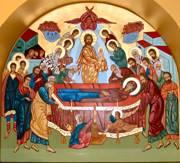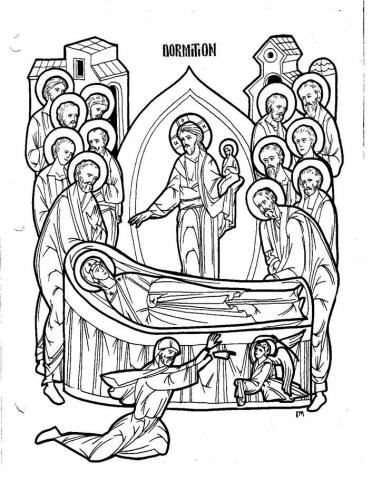Dormition
DORMITION

Objectives:
1. Children should be able to tell the story of the dormition and to recognize the characters in the icon.
2. Why do we bring flowers for the dormition?
Possible Lesson Plan:
1. Open with prayer.
2. Show the icon of the Dormition. Identify the characters and tell the story:
After the day of Pentecost, Mary stayed in the city of Jerusalem living with the disciple John. She comforted and worked lovingly with the new Christian church. When Mary was about 50 years old, she was sick and dying. At that time, all of the apostles were scattered around the world preaching the Gospel. When they heard of Mary’s death, they all returned to Jerusalem. All arrived in time for her burial except St. Thomas, also known as Doubting Thomas. The apostles are pictured on either side of Mary, St. Peter at the head of the bier and St. Paul at the foot of the bier.
Below the bier in the icon we see Antoninus the Jew. He was an enemy of the Christian community and tried to break up the burial of Mary by dumping over the bier. An archangel appeared and cut off the hands of Antoninus to keep him from dishonoring the Theotokos. Then Antoninus knew that Jesus really was Lord and he was healed and became a believer.
When Thomas arrived, the other disciples took Thomas to the tomb in Gethsemane where Mary had been buried near her parents, Joachim and Anna. But the tomb was empty! The Church believes that Mary was resurrected bodily and taken to heaven, just as we all will be in the future.
- Feed the Elephant/True or false:
True False
Dormition means “falling asleep”. Below the bier in the icon we see Jesus.
Sts. Peter and Paul are in the icon. Thomas arrived on time to see Mary.
The apostles returned for Mary’s death. Mary died in Rome.
Mary died in Jerusalem. Antoninus was Mary’s friend.
Doubting Thomas found Mary’s Mary lived to be 100 years old.
empty tomb.
- Discuss the association of flowers with this feast. According to tradition, when the apostles went to visit the tomb of Mary, instead of finding her body, they found only the burial cloths and the tomb was filled with the fragrance of flowers. We bring flowers to church to be blessed and place them at the icon of the Theotokos. We can then take home the flowers to give her fragrance to our homes.
- If the weather permits, gather some flowers. Make a bouquet and place it beneath Mary’s icon, or dry the flowers to be used later in candle decorating.
- Craft Idea: We celebrate this feast with flowers. Make a tiny "Mary Garden" with a pot or jar or plastic container. Fill with dirt. Color icon of the Theotokos and attach to outside of pot or stand inside the pot on a popsicle stick, or print the icon of the feast and glue or tape to the outside of the pot. Paint a rock for a ladybug. Plant 1-2 flowers that symbolize Mary. Some ideas include:
- Rose: The Queen of flowers
- Marigolds: Mary’s Gold
- Rose”Mary”
- Lily of the Valley: Also known as “Mary’s Tears”
- Alyssum: with cross-shaped flowers
- Impatiens: also known as “Mother’s Love”
- Morning Glory: also known as “Mary’s Mantle” with its blue color
Another craft idea: OK, too hard and messy for your space and time. How about a "quadriptych" for the Theotokos. This is the last of the 4 feasts devoted to Mary. Take blue construction paper or cardstock (why blue) and cut into a 4-arched card. Print small versions of perhaps only part of the icon for each of her feasts. Let the children color and glue into place. Decorate with flower stickers if desired and print the names of the feasts in the correct panels. The children can fold the quadriptych between the arches like a fan to make it stand up.
All of these too hard? Try one or more flowers from lots of different materials.
- Close with prayer.
